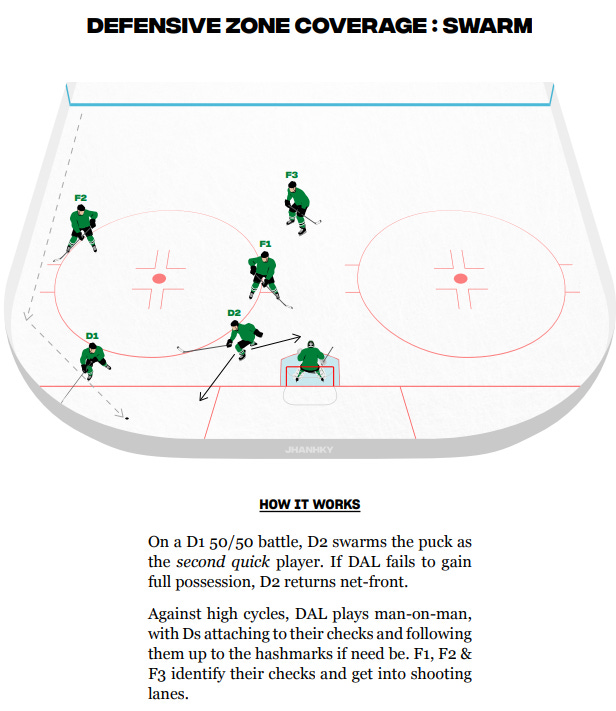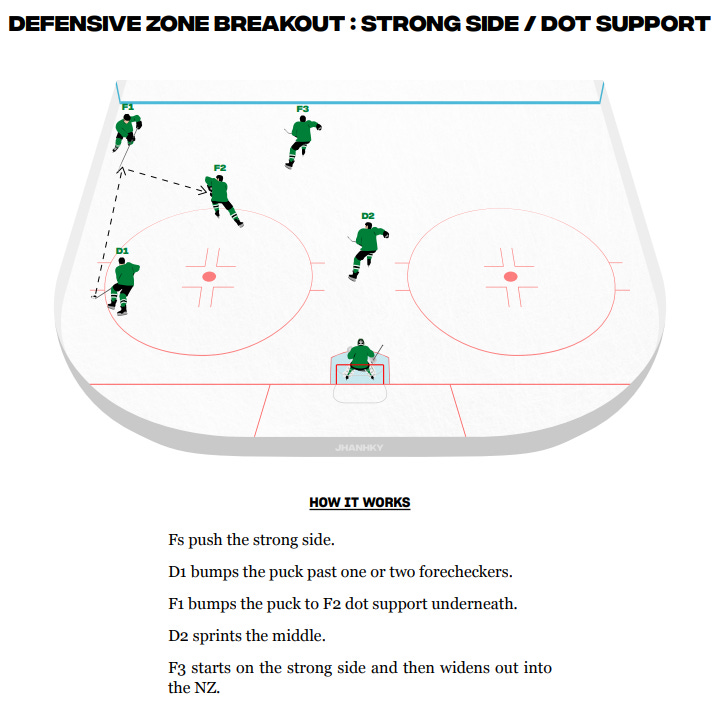Systems Check: From Zone to Zone, What's in Store Under DeBoer?
Five years later, the 2022-2023 roster is getting a systems makeover with actual plans of offense (!).
Say goodbye to this.
Aggressive defense all over the ice.
The offense will take care of itself.
Under Pete DeBoer, offense won’t be expected to care of itself. On the contrary; offense will have intention, meaning, priority, design, and method. Time in the offensive zone will be about time in the offensive zone — not worrying about what could happen in the defensive zone if a chance goes back the other way. In short, offense will take care of itself with the right plan and strategy. It won’t be a marathon for which player can be the power ball winner for the night.
But what exactly will that mean for DeBoer? And what does that mean for the other two zones as well?
All visuals taken from Jack Han’s Hockey Tactics 2022 Playbook.
I’m not gonna talk too much about this. I noticed the early track years ago when I did a deep dive into Bowness’ forecheck. I’ll give Bowness credit for one thing: there’s nothing like it. Literally. No other team uses the offensive zone as a place to integrate defensive schemes. So how does DeBoer’s system in the offensive zone differ?
The first thing you’ll notice is that, unlike Bowness, Dallas won’t always have only two players deep in the zone. The problem with Dallas’ goal scoring ability in recent years is that they couldn’t generate off the cycle OR rush: players fought for pucks, brought the puck high, and then low again hoping the forwards would grab a rebound. Except rebounds are coin flips. While DeBoer wants defenseman taking more shots, that’s not the same as aimlessly firing from the point. In the 2020-2021 season, DeBoer’s Knights were elite at generating intentional offense in a variety of ways.
Data via Corey Sznajder from 2020-2021.
That’s the good news.
Is there bad news? No. But Vegas had a trio of defenders who could reliably activate between Shea Theodore, Alex Pietrangelo, and Alec Martinez. Dallas, conversely, has Miro Heiskanen and rookie Nils Lundkvist. DeBoer expects all of his defensemen to activate when given the opportunity. Will this mean upticks in production for Esa Lindell, Jani Hakanpaa, Ryan Suter, and Colin Miller? Maybe. To me, the real question is not about which defenders might accidentally produce more but rather: what kind of offense is Dallas’ roster capable of? Do they have the speed to be a rush team? The size to be a cycle team? A bit of both, or less of both?
For the forwards, offensive zone play under DeBoer is all about puck management. Can the first forward on the forecheck maintain control of the puck, and are they strong enough on their feet to create space with it? Will they have the vision to catch activating defensemen, and will the other forwards be adept at driving to the middle? Are the players entering the zone with speed?
Here was Dallas’ rush attack under Bowness.
If you’re wondering by Han highlighted the top line’s attack rather than the system at large…well, you know why. Dallas dumped, and chased, chased and dumped. However, calling Dallas’ attack dump and chase is too kind. Dump and chase implies purpose. Dallas didn’t run dump and chase. Dallas played Fetch. The clip I highlighted at 11:40 in my YT video linked above was a perfect example, with players working so hard for so little (Radek Faksa even referenced this in a recent interview, referring to how the energy spent defending so much took away his energy once inside the offensive zone). There’s nothing inherently wrong with dump and chase as an option. There is, however, something deeply wrong with refusing to do anything else.
What can we expect under DeBoer? Well, zone entries with possession, for one.
It’ll be interesting to see if Dallas can execute some of DeBoer’s requirements: namely, long passes and speed in the neutral. These two things don’t describe Dallas’ roster all that well. Except for the top line, Dallas doesn’t have any dedicated passers. And except for a small group of players, they don’t have a ton of speed. Admittedly that “small group” is growing bigger. Johnston’s most important offensive talent is his passing. Lundkvist, despite his shot getting all the hype, is a playmaker by trade. Will that be enough though? Because DeBoer doesn’t fuck around on the rush.
Data via Corey Sznajder from 2020-2021.
Since Ken Hitchcock took over, the Stars are:
14th in expected goals per 60 at even strength.
However…they are,
32nd in shooting percentage at even strength.
This season will be the ultimate test of two competing explanations for why Dallas has underachieved offensively. It’s “Benn and Seguin Have Failed Multiple Coaches” versus “Multiple Defense-First Coaches Have Failed the Offense.” I’m in the latter camp for reasons I think Corey’s data makes clear: it doesn’t matter how close you are to the net if the goaltender expects you to be there. That’s why rush/cycle attacks are so effective — more movement means less time for goalies to adjust.
What about the defensive zone? Under Bowness, Dallas took a strength in numbers approach.
A swarm defense is what it sounds like: swarm the puck enough, and it won’t matter where the opposing player will try to take it. The whole point is to overload the strongside (i.e. where the puck is) so that the weakside (i.e. where the puck isn’t) is never an option. Bowness deserves credit for this IMO: recognizing that Dallas had the bodies for this. The Stars are a strange bunch when you look at them as a whole: neither big nor fast, they’re a loose coalition of defensive impulses. A swarm defense is a good option for a defensive core with so much variation in profiles.
They couldn’t pull off something like what Cooper does in Tampa, with its collapsing system. A collapsing defense is where the first defender and forward on the puck form the swarm component to create a defense that defends the inside (i.e. puck behind the net) first, and the outside (i.e. puck at the point) second. The Lightning do this effectively because they have a large blueline that can cover so much space. Nor can Dallas do what Colorado does under Bednar, with their emphasis on high coverage. They have the speed to force teams into respecting the counterattack.
How a team defends affects how they attack. The swarm defense allowed Dallas to break out with numbers.
It’s a good strategy against aggressive forechecks. Less so against less aggressive forechecks; not to mention, having everyone attack the same way will play to the team’s floor rather than its ceiling. It’s no surprise that certain offensive players didn’t thrive in Bowness’ system. His attack wasn’t interested in taking advantage of individual talent. It was only interested in a strict adherence to tactics.
How does DeBoer’s profile?
DeBoer’s defense is a little like the opposite of Tampa’s, with its focus on defending the outside (cutting off weakside options before they happen by focusing on the pass) first, and the inside (where the puck is) )second. It’s a good defense for teams with speed. Vegas didn’t have the most dangerous group of forwards, but had a decent amount of speed up and down the lineup.
This leads us to DeBoer’s breakouts, which rely on…speed (!).
Yes, plans of attack can help take care of offense too. That’s why DeBoer’s teams have been so good on the rush: they build speed as soon as possible.
The thing about systems is that they’re malleable. Just because DeBoer did breakouts a certain way in Vegas doesn’t mean he’ll simply transport them over into Dallas. Systems, especially at the pro level, are largely designed with the roster in mind. It’s possible we’ll see a different system than the ones outlined above. Whatever changes, DeBoer’s signature is unmistakable: reads in the defensive zone, speed through the neutral, all-hands-on-deck in the offensive zone.
Full disclosure: I’ve been waiting for this ever since it was clear in 2017 that Hitchcock’s system wasn’t good enough, and wouldn’t ever be good enough. So yea; about damn time.













Excited to see if we have the personnel to pull this off with (Hopefully) offensive numbers closer to top 10. If not JN has more work to do.
Great read, David, and the visuals were very helpful in explaining the various systems and strategies. As someone who doesn’t know a lot about hockey X’s and O’s, I really enjoyed diving into this.